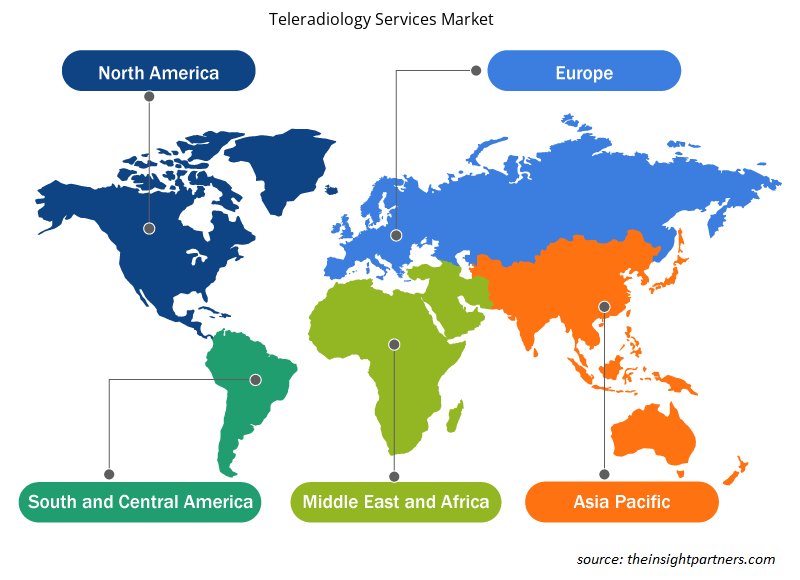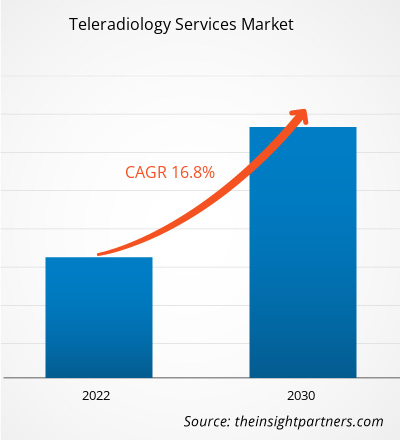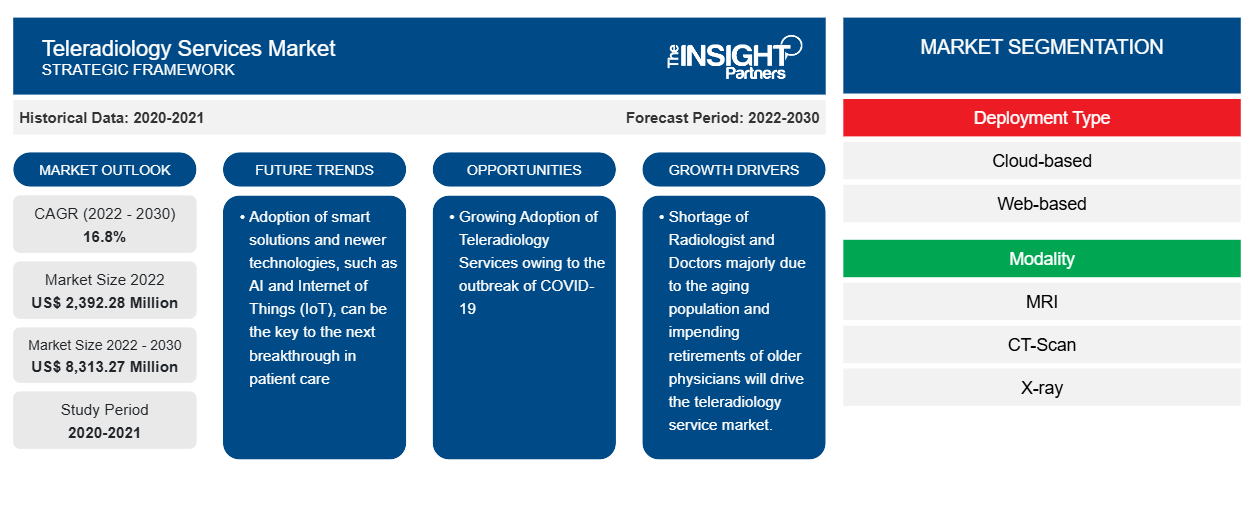远程放射服务市场预计将从 2022 年的 23.9228 亿美元增长到 2030 年的 83.1327 亿美元;预计 2022 年至 2030 年的复合年增长率为 16.8%。随着医疗设备连接使用量的增加,对更好的网络和技术的需求也随之增加,而 5G 就是这样一种可能继续成为市场主要趋势的技术。
远程放射学服务市场分析
推动市场发展的因素包括放射科医生和医生的短缺以及远程放射学服务的日益普及。此外,在远程放射学中采用人工智能 (AI) 为远程放射学服务市场在未来的预测期内创造了增长机会。虽然短期内难以培养和培训满足需求所需的放射科医生数量,但采用智能解决方案和新技术(如人工智能和物联网 (IoT))可能是患者护理下一个突破的关键。
远程放射学服务市场概览
全球范围内,医疗专业人员(例如放射科医生、内科医生和医生)严重短缺。根据 2023 年 7 月发表的文章《弥补差距:应对日益严重的放射科短缺的策略》,约 80% 的医疗系统报告其放射科存在短缺。此外,根据美国医学院协会的分析,到 2034 年,放射科医生和其他专家的短缺人数可能超过 35,000 人。根据美国国家医学图书馆发表的文章《英国放射科劳动力危机及其应对策略:人工智能是救星吗?》,2020 年英国放射科劳动力短缺 33%,预计到 2024 年将上升到 44%。根据同一篇文章,约 71% 的英国放射科临床主任认为他们没有足够的放射科医生来提供安全有效的患者护理。
定制此报告以满足您的需求
您可以免费定制任何报告,包括本报告的部分内容、国家级分析、Excel 数据包,以及为初创企业和大学提供优惠和折扣
-
获取此报告的关键市场趋势。这个免费样品将包括数据分析,从市场趋势到估计和预测。
远程放射服务市场驱动因素和机遇
远程放射学服务的普及率不断提高
远程放射学是远程医疗的一个分支,涉及以多种方式将放射医学图像从一个地方传输到另一个地方,以便与其他放射科医生和医师共享研究结果,进行分析和解释。由于 2019 年 11 月 COVID-19 疫情爆发,美国疾病控制与预防中心 (CDC) 于 2020 年 2 月发布指导意见,要求受疫情影响地区的医疗服务提供者和人员保持社交距离,并通过远程医疗等虚拟方式提供临床服务。CDC 对疫情初期远程医疗服务的使用频率进行了研究,分析了美国四家最大的远程医疗服务提供商在所有州提供服务的情况。
远程放射学中人工智能 (AI) 的应用
物联网的出现推动了各种健康实践的发展,以改善人口健康。这些服务具有广泛的信息量,可用于单一疾病和集群疾病管理的各种目的,包括允许医疗保健专业人员远程跟踪和监控患者进展、改善慢性病的自我管理、协助及早发现异常,以及加速症状识别和临床诊断。此外,物联网驱动的应用程序有可能更好地利用医疗资源,同时提供高质量、低成本的医疗服务。例如,Mobile MIM 应用程序是 Apple App Store 中的第一个医疗应用程序。它用于查看、注册、融合和显示 SPECT、PET、CT、MRI、X 射线和超声检查的医学图像,以用于诊断目的。Mobile MIM 通过提供对医学图像的无线和便携式访问,增强了医生对图片的访问,并允许他们与同行进行咨询。人工智能可以帮助创建一个内置系统,根据协议要求对病例进行优先排序。
远程放射学服务市场报告细分分析
有助于得出远程放射服务市场分析的关键部分是产品和最终用户。
- 根据部署类型,远程放射服务市场分为基于云和基于网络两类。基于云的细分市场在 2023 年占据了最大的市场份额。
- 根据方式,远程放射服务市场分为 MRI、CT-SCAN、X 射线、超声波等。CT-SCAN 部分在 2023 年占据了最大的市场份额。
- 根据应用,市场细分为肌肉骨骼系统、胃肠病学、心脏病学、肿瘤学、神经病学等。粘膜骨骼部分在 2023 年占据了最大的市场份额。
- 根据最终用户,远程放射服务市场分为医院和诊所、诊断和影像中心等。医院和诊所部分在 2023 年占据了最大的市场份额。
远程放射学服务市场份额(按地区)分析
远程放射服务市场报告的地理范围主要分为五个地区:北美、亚太、欧洲、中东和非洲、南美和中美。
在北美,美国是远程放射学服务的最大市场。远程放射学已成为一种潜在的解决方案,小型中风专家可以指导当地急诊医生进行全面的神经系统检查、影像检查和管理决策。据 IntechOpen 称,中风是美国第五大死亡原因,大约每 40 秒就会发生一次中风,大约每 4 分钟就会发生一次与中风相关的死亡。远程放射学网络使用数字技术进行双向高清视频电话会议,通过为美国各地服务不足的社区提供安全、高效且负担得起的护理来弥合这些差异。
远程放射学网络(如传统诊所)必须遵守《健康保险流通与责任法案》(HIPAA),该法案规定了国家医疗信息的保护。全国范围内远程放射学的使用增加,可以更广泛地及时获得急症护理专业知识,并有助于填补区域性中风护理的空白。
远程放射学服务市场区域洞察
Insight Partners 的分析师已详尽解释了预测期内影响远程放射学服务市场的区域趋势和因素。本节还讨论了北美、欧洲、亚太地区、中东和非洲以及南美和中美洲的远程放射学服务市场细分和地理位置。

- 获取远程放射学服务市场的区域特定数据
远程放射学服务市场报告范围
| 报告属性 | 细节 |
|---|---|
| 2022 年市场规模 | 23.9228亿美元 |
| 2030 年市场规模 | 83.1327亿美元 |
| 全球复合年增长率(2022 - 2030 年) | 16.8% |
| 史料 | 2020-2021 |
| 预测期 | 2022-2030 |
| 涵盖的领域 |
按部署类型
|
| 覆盖地区和国家 |
北美
|
| 市场领导者和主要公司简介 |
|
市场参与者密度:了解其对商业动态的影响
远程放射学服务市场正在快速增长,这得益于终端用户需求的不断增长,这些需求源于消费者偏好的不断变化、技术进步以及对产品优势的认识不断提高等因素。随着需求的增加,企业正在扩大其产品范围,进行创新以满足消费者需求,并利用新兴趋势,从而进一步推动市场增长。
市场参与者密度是指在特定市场或行业内运营的企业或公司的分布情况。它表明在给定市场空间中,相对于其规模或总市场价值,有多少竞争对手(市场参与者)存在。
在远程放射学服务市场运营的主要公司有:
- Aster 医学影像有限公司
- RAYUS 放射科服务
- ONRAD 公司
- 麦达维斯有限公司
- 真实放射学有限责任公司
- 远程放射学解决方案公司
免责声明:上面列出的公司没有按照任何特定顺序排列。

- 获取远程放射学服务市场顶级关键参与者概览
远程放射服务市场新闻和最新发展
远程放射学服务市场通过收集主要和次要研究后的定性和定量数据进行评估,其中包括重要的公司出版物、协会数据和数据库。远程放射学服务市场的一些发展如下:
- 远程医疗实践管理组织 Yellowcross Healthcare Commerce 推出了一项新的咨询服务,帮助医疗团体和医疗机构扩展其远程护理能力。(来源:Yellowcross,公司网站,2024 年 2 月)
远程放射学服务市场报告覆盖范围和交付成果
“远程放射服务市场规模和预测(2021-2031)”报告对市场进行了详细分析,涵盖以下领域:
- 远程放射学服务市场规模及全球、区域和国家层面所有主要细分市场的预测
- 远程放射服务市场趋势以及市场动态,如驱动因素、限制因素和关键机遇
- 详细的 PEST/波特五力分析和 SWOT 分析
- 远程放射服务市场分析涵盖主要市场趋势、全球和区域框架、主要参与者、法规和最新的市场发展。
- 行业格局和竞争分析,涵盖市场集中度、热图分析、知名参与者以及远程放射服务市场的最新发展
- 详细的公司简介
- 历史分析(2 年)、基准年、预测(7 年)及复合年增长率
- PEST和SWOT分析
- 市场规模、价值/数量 - 全球、区域、国家
- 行业和竞争格局
- Excel 数据集
近期报告
客户评价
购买理由
- 明智的决策
- 了解市场动态
- 竞争分析
- 客户洞察
- 市场预测
- 风险规避
- 战略规划
- 投资论证
- 识别新兴市场
- 优化营销策略
- 提升运营效率
- 顺应监管趋势























 获取免费样品 - 远程放射学服务市场
获取免费样品 - 远程放射学服务市场